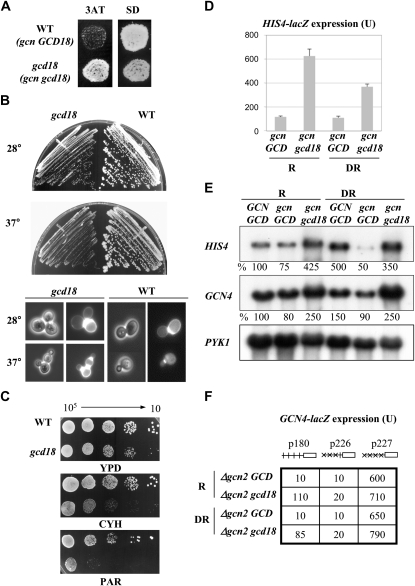Figure 2.—
Gcd− (3ATR), slow growth (Slg−), cell morphology defects, and antibiotic sensitivity phenotypes of the H166 mutant (gcd18-1). (A) 3ATR phenotype of H166 (gcn2-101 gcn3-101 gcd18-1) relative to the 3ATs of the isogenic wild-type strain H117 (gcn2-101 gcn3-101 GCD18). Isolated colonies of each strain were grown on minimally supplemented SD plates for 2 days and replica printed to plates containing 10 mm 3AT and to new SD plates, which were incubated at 28° for 3 days. (B) Slow growth and aberrant cell morphologies of the gcd18 mutant. Cells of H117 and of the H166 mutant were streaked for single colonies on yeast extract-peptone dextrose medium plates (YPD) that were incubated at 28° or 37° for 3 to 7 days (top). Cells were grown for 12 hr in liquid YPD at 28° or 37° fixed with 4% formaldehyde and stained with Calcofluor White (Ufano et al. 2004). Pictures were taken under a phase-contrast microscope using visible or an UV filter (×40). (C) Increased sensitivity of gcd18 mutants to compounds that inhibit mRNA translation. Serial dilutions (105–10) of cells from the same strains as above growing exponentially were plotted on YPD plates and on YPD containing 25 ng/ml of cycloheximide (CYH) or 500 μg/ml of paromomycin (PAR). (D and E) The gcd18-1 mutation increases expression of the HIS4 gene. (D) Cells of isogenic strains H117 (gcn GCD18) and H166 (gcn gcd18-1) were grown under repressing (R), amino acid replete conditions (SD medium), and under derepressing (DR) conditions of histidine starvation induced by 3-aminotriazole (10 mm 3AT) during 6 hr at 28°. The β-galactosidase activity synthesized from an integrated HIS4–lacZ allele was measured in the corresponding WCE (materials and methods). Results are the average of three independent determinations. (E) Total RNA was extracted from strains F35 (GCN GCD), H117 (gcn GCD18), and H166 (gcn gcd18) grown as indicated above, and 10 μg analyzed by Northern using radiolabeled probes specific to visualize HIS4, GCN4, and PYK1 mRNAs (materials and methods). The hybridization signals were quantified with a phosphorimager and values, normalized relative to PYK1 mRNA, are given in percentages below each panel relative to the corresponding values in F35, which were set to 100%. (F) The gcd18-1G388D mutation leads to constitutive derepression of GCN4–lacZ independently of the positive Gcn factors. GCN4–lacZ fusions were introduced into isogenic strains Hm520 (Δgcn2 GCD18) and Hm521(Δgcn2 gcd18-1) on low-copy number plasmids p180, p226, and p227. The four uORFs in the leader sequence of p180 are shown as small vertical lanes, and point mutations that remove the AUG codons of uORFs 1–3 (p226) or 1–4 (p227) are shown as Xs. β-Galactosidase activity was measured in WCE of cells grown to midlogarithmic phase under nonstarvation, repressing (R) conditions or derepressing (DR) conditions of histidine starvation induced by 3AT. Values are average of results obtained in three independent determinations with two independent transformants.

